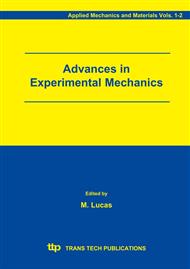p.51
p.59
p.65
p.71
p.81
p.87
p.93
p.99
p.107
Fatigue Life and Residual Strength Analysis of Steel-Composite Joints
Abstract:
There are many instances where the use of weight saving composite materials for an entire structure is either; too complex, too expensive or unfeasible. In these circumstances the use of a hybrid structure can incorporate the benefits of traditional construction materials, for example steel, coupled with the advantages of composite materials in weight critical areas. In the present study, an investigation was undertaken into the fatigue life characterisation of a hybrid joint for marine application. In addition the residual strength of the joint, after a fixed number of fatigue cycles, was assessed under axial compression and bending loads. A progressive damage model was developed to predict the location of major stress concentrations, the path of damage and subsequent loss in stiffness of the joint under axial compression.
Info:
Periodical:
Pages:
81-86
Citation:
Online since:
September 2004
Authors:
Keywords:
Price:
Сopyright:
© 2004 Trans Tech Publications Ltd. All Rights Reserved
Share:
Citation:


